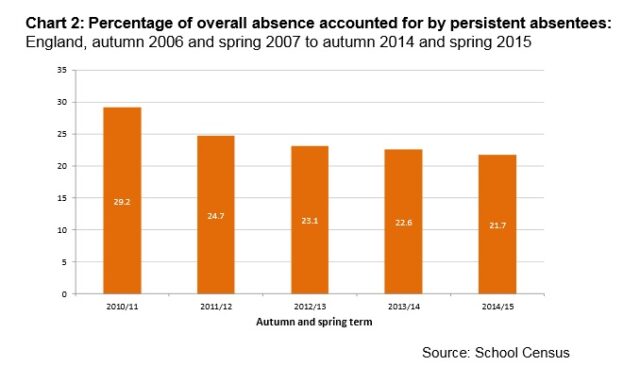Pupil absence increased slightly last year with rises in pupil illness to blame, according to official government statistics.
Figures from the Department for Education show authorised absence rates for pupils running at 3.6 per cent across state-funded primary and secondary schools in autumn 2014 and spring 2015.
Unauthorised absence rates remained static at 0.9 per cent, even after the government’s increased efforts in fining more than 16,000 parents for their child’s truancy.
So, what are the key things of note in today’s figures?
1. Absence from illnesses increased: is it a case of mutant flu?
The increase in absence is almost entirely attributed to more illness among children. (See above). But why?
No explanation is given in the government figures but the BBC reported in January a spike in flu cases and that figures would be watched as children returned to school after the holiday break – a period in which infections are commonly spread across families.
2. Children who persistently truant are diminishing in number
Pupils who missed 38 or more ‘sessions’ in the autumn and spring term are considered ‘persistent absentees’.
All schools have two sessions per day. So missing 38 is the equivalent of missing 19 days of school over two terms.
Whatever schools are doing to bring down the number of pupils in this category is working.
Persistent absentees are now a much smaller proportion of absentees and the number of them is also decreasing, albeit slowly.
The ones that are left, though, are increasing their average amount of absences. The government report doesn’t say why.

3. Despite the government taking more families to court, children are out of school on family holidays for the same amount of time as before
Family holidays are now a less common reason for absence. But the percentage of of all possible sessions missed due to family holidays remained the same between last year’s data and this year’s. (It was 0.3 per cent, if you’re interested)
4. GCSE takers have the highest rate of absence
Pupils in year 11 have an absence rate of 5.9 per cent. This compares to an absence rate of just 3.8 per cent for year 3 and 4.
The figures are taken from the autumn and spring term only. So factors like ‘study leave’ are not included in the year 11 figures. They do, however, include absences for college interviews or entrance tests.
5. Pupils from different ethnicity groups have vastly different absence rates
Pupils identified as Traveller with Irish Heritage have an absence rate of 16.9 per cent. This is the equivalent of one missed half day per week.
Chinese and Black African pupils have the lowest absence rates at 2.5 per cent and 2.7 per cent respectively.
For analysis by local region see our previous reporting.







The government could cut the absences due to illness at a stroke, by immunising children against chicken pox, a simple and cheap process.
The department of healt chooses not to include this in the range of childhood immunisations, thereby condemning most children to around a week off school.
I always found it odd that the government makes such a fuss over time off school whilst at the same time, for the sake of a 20p jab, it readily lets a contagious virus “harm” children’s education.